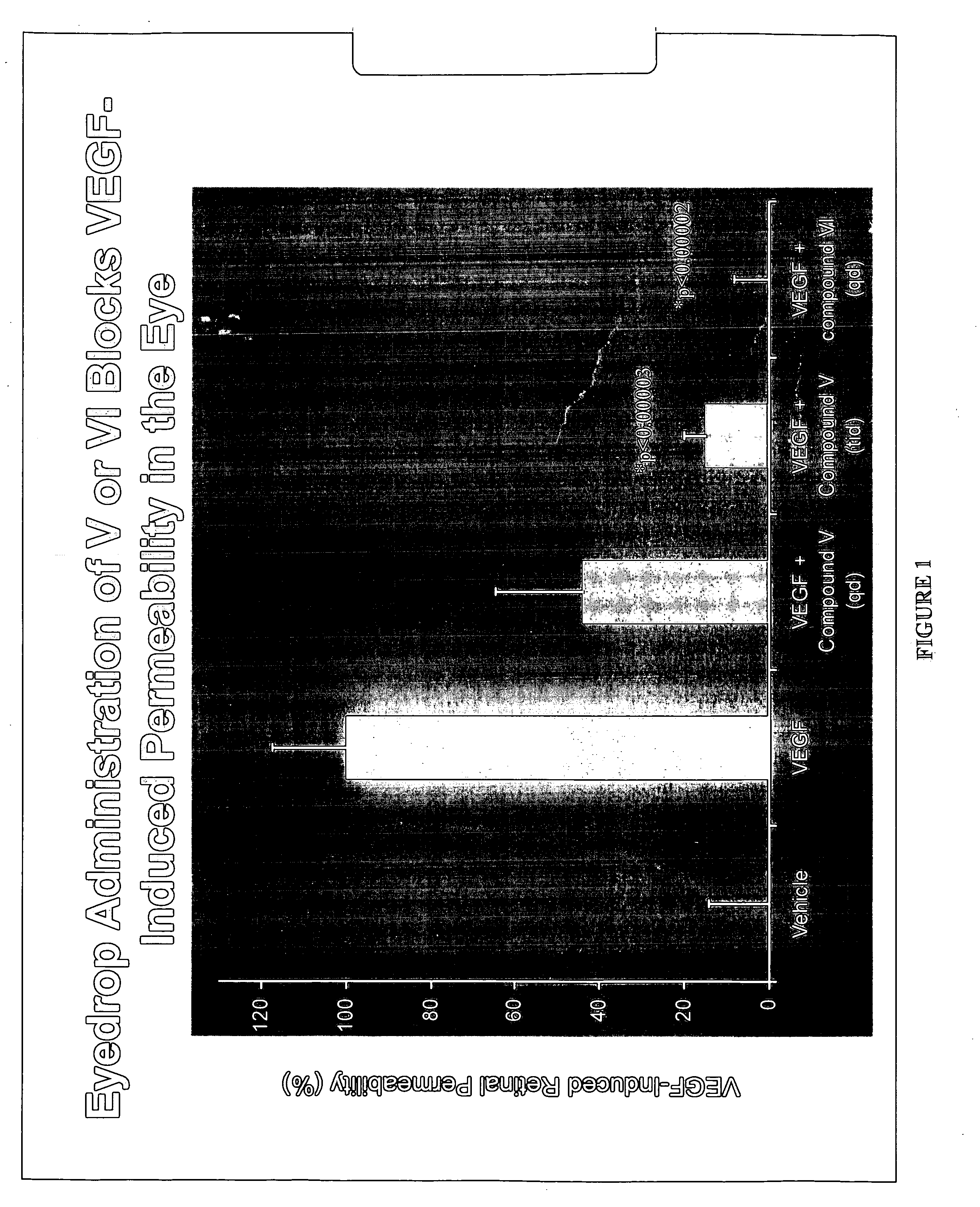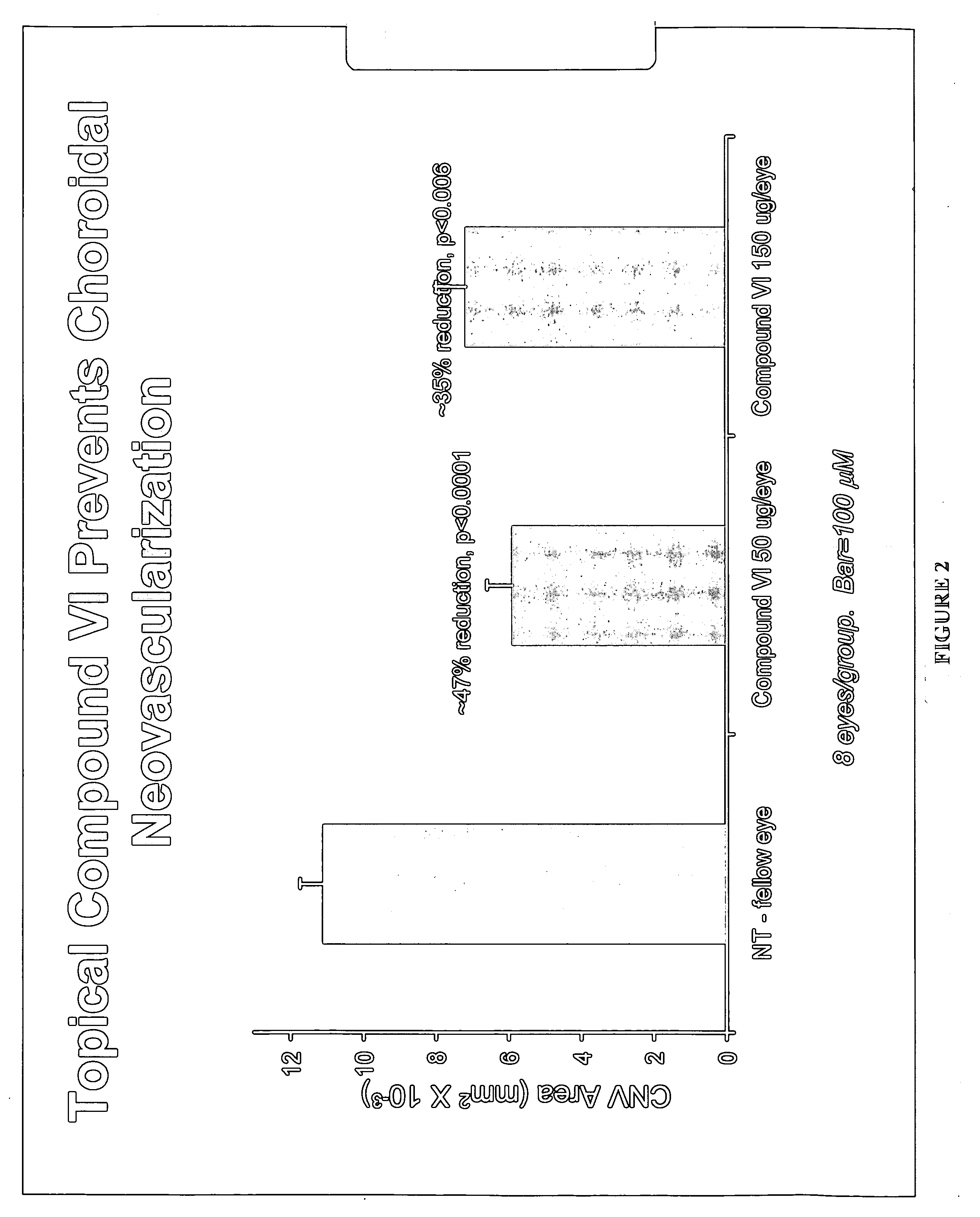Methods and compositions for the treatment of ocular disorders
a technology for ocular disorders and compositions, applied in the field of ocular conditions, can solve the problems of insufficient ocular bioavailability, ineffective intraocular delivery of therapeutic agents, and inability to achieve the effect of delivering therapeutic agents,
- Summary
- Abstract
- Description
- Claims
- Application Information
AI Technical Summary
Benefits of technology
Problems solved by technology
Method used
Image
Examples
example 1
Preparation of Water Continuous Lipid Based Colloidal Suspension Containing Compound (V)
[0133] A water continuous lipid based colloidal suspension was prepared by taking 18 mg of Compound (V) in the form of a HCl salt, mixing with 550 mg of dimyristoyl phosphatidylcholine (DMPC), 2412 mg of a 2.9% propylene glycol, and homogenizing using a sonicator probe in a temperature controlled bath. The pH was adjusted to 5-6 using 35 μL of a 0.1 N NaOH, and the composition was further sonicated to ensure homogeneity. The resulting formulation was sterile filtered through a 0.22 μm PVDF syringe filter.
[0134] Alternatively, the drug may be homogenized using high pressure homogenization. If desired, the drug may be pre-dissolved with the lipid prior to homogenization in water with the aid of an organic solvent such ethanol or chloroform. If desired, the resulting formulation may also be autoclaved to achieve sterility in the final container. If desired, preservatives, such as benzalkonium chlo...
example 2
Preparation of Water Continuous Lipid Based Colloidal Suspension Containing Compound (XI)
[0135] A water continuous lipid based colloidal suspension was prepared by taking 37.6 mg of Compound (XI) in the form of an HCl salt, mixing with 550 mg of DMPC, 2412 mg of a 2.9% propylene glycol, and homogenization using a sonicator probe in a temperature controlled bath. The pH was adjusted to 5-6 using 15 μL of a 50 mg / mL sodium oleate in de-ionized water, and the suspension further sonicated to ensure homogeneity. The resulting formulation was sterile filtered through a 0.22 μm PVDF syringe filter.
[0136] Alternatively, the drug may be homogenized using high pressure homogenization. If desired, optionally the drug may be pre-dissolved with the lipid prior to homogenization in water with the aid of an organic solvent such ethanol or chloroform. If desired, the resulting formulation may also be autoclaved to achieve sterility in the final container. If desired, optionally preservatives, suc...
example 3
Pharmacokinetic Studies of Compound (XI) in Dutch-Belted Rabbits After Topical Administration
[0137] A formulation was prepared as in Example 1 but using Compound (XI) instead of Compound (V). Compound (XI) was administered as eyedrops (1% API, 50 μL) BID for 3 days. On day 3 following a single dose, rabbits were sacrificed, enucleated and various ocular tissues (retina, choroid, cornea, etc) collected. Concentrations in the tissues were measured using LC / MS / MS, following tissue homogenization and acetonitrile precipitation. PK data analysis was conducted using WINNONLIN program. Concentrations of compound V in the choroid were similar between the 2 formulations (at the μM level). Half-life was long at approximately 8 hours.
PUM
| Property | Measurement | Unit |
|---|---|---|
| Mass | aaaaa | aaaaa |
| Mass | aaaaa | aaaaa |
| Mass | aaaaa | aaaaa |
Abstract
Description
Claims
Application Information
 Login to View More
Login to View More - R&D
- Intellectual Property
- Life Sciences
- Materials
- Tech Scout
- Unparalleled Data Quality
- Higher Quality Content
- 60% Fewer Hallucinations
Browse by: Latest US Patents, China's latest patents, Technical Efficacy Thesaurus, Application Domain, Technology Topic, Popular Technical Reports.
© 2025 PatSnap. All rights reserved.Legal|Privacy policy|Modern Slavery Act Transparency Statement|Sitemap|About US| Contact US: help@patsnap.com



